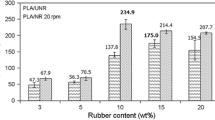Abstract
Premastication of natural rubber (NR) is a common process to ease the incorporation of fillers and chemicals. This research studied the changes in molecular structure, molecular weight (MW), and linear viscoelastic (LVE) properties of the standard Thai NR block grade STR5L, which is the low contamination grade, after mastication for 20 min at 40, 70, and 100 rpm, respectively. The MWs of unmasticated and masticated NRs were quantified by size exclusion chromatography. The “dual constraint” model, which is known to provide good predictions of the LVE properties from the MW and molecular weight distribution (MWD) of linear polymers, was used to correlate the MWs of NRs to their LVE properties. It was found that the dual constraint model could predict the dynamic moduli of NRs masticated at high speeds (70 and 100 rpm), indicating that the rheological behavior of the masticated NRs at 70 and 100 rpm conformed to linear polymers. On the other hand, the predictions for the unmasticated NR and the NR masticated at a lower speed of 40 rpm (NR40 rpm) deviated from the experimental values, especially in the terminal zone. This deviation might be due to the presence of physical gel and microgel in NR, which might still exist at mastication temperatures below 100 °C.









Similar content being viewed by others
References
Amnuaypornsri S, Tarachiwin L, Sakdapipanich JT (2010) Character of long-chain branching in highly purified natural rubber. J Appl Polym Sci 115:3645–3650
Ball RC, McLeish TCB (1989) Dynamic dilution and the viscosity of star polymer melts. Macromolecules 22:1911–1913
Berry GC, Fox TG (1968) The viscosity of polymers and their concentrated solutions. Adv Polym Sci 5:261–357
Busse WF, Cunningham EN (1938) Mastication of rubber: a study of some of the oxidation processes involved. Proceedings of the 2nd Rubber Technology Conference, pp 288–292
Dimier F, Vergnes B, Vincent M (2004) Relationships between mastication conditions and rheological behavior of a natural rubber. RheologicaActa 43:196–202
Doi M, Edwards SF (1986). The Theory of Polymer Dynamics, Clarendon, Oxford
Ehabe EE, Bonfils F (2011) Novel insight into the gel phase of Hevea natural rubber. Journal of Rubber Research 14(1):1–10
Ehabe EE, Bonfils F, Sainte-Beuve J, Collet A, Schué F (2006) High-temperature mastication of raw natural rubber: changes in macrostructure and mesostructure. Polymer Engineering and Science pp:222–227
Ferry JD (1980) Viscoelastic properties of polymers, 3rd edn John Wiley& Sons
Kim C, Beuve JS, Guilbert S, Bonfils F (2009) Study of chain branching in natural rubber using size-exclusion chromatography coupled with a multi-angle light scattering detector (SEC-MALS). Eur Polym J 45:2249–2259
Kurata M, Tsunashima J (1999) Viscosity-molecular weight relationships and unperturbed dimensions of linear chain molecules. In: Brundrup J, Immergut EM, Grulke EA (eds) Polymer handbook, 4th edn. Wiley, New York
Leblanc JL, Pilard JF, Pianhanuruk E, Campistron I, Buzare´ JY (2010) Characterizing gum natural rubber samples through advanced techniques. J Appl Polym Sci 119:3058–3071
Léonardi F, Allal A, Marin G (2002) Molecular weight distribution from viscoelastic data: the importance of tube renewal and rouse mode. J Rheol 46(1):209–224
Likhtman AE, McLeish TCB (2002) Quantitative theory for linear dynamics of linear entangled polymers. Macromolecules 35:6332–6343
Milner ST, McLeish TCB, Young RN, Hakiki A, Johnson JM (1998) Dynamic dilution, constraint-release, and star-linear blends. Macromolecules 31:9345–9353
Mullins L, Watson WF (1959) Mastication: shear dependence of degradation on hot mastication. J Appl Polym Sci 1:245–249
Pattamaprom C, Larson RG (2001) Constraint release effects in monodisperse and bidisperse polystyrenes in fast transient shearing flows. Macromolecules 34:5229–5237
Pattamaprom C, Larson RG, Sirivat A (2008) Determining polymer molecular weight distributions from rheological properties using the dual-constraint model. Rheologica Acta 47(7):689–700
Pattamaprom C, Larson RG, van Dykes TJ (2000) Quantitative predictions of linear viscoelastic rheological properties of entangled polymers. RheologicaActa 39:517–531
Sakdapipanich JT (2007) Structural characterization of natural rubber based on recent evidence from selective enzymatic treatments. J Biosci Bioeng 103(4):287–292
Shiibashi T, Hirose K, Tagata N (1989) Gel structures of natural rubber and synthetic isoprene rubber. Kobunshi Robunshu 46(8):465–472
Stern HJ (1967) Rubber: natural and synthetic, 2nd edn. Maclaren and Sons Ltd., London, pp. 318–320
Tangpakdee J, Tanaka Y (1993) Characterization of sol and gel in HEVEA natural rubber. Journal of Rubber Chemistry and Technology 70:707–713
Tarachiwin L, Tanaka Y, Sakdapipanich J (2005) Structure and origin of long-chain branching and gel in natural rubber. Kautschuk Gummi Kunststoffe 58(3):115–122
Valsamis LN, Canedo EL, Donoian GS (1997) Evaluating the performance of internal mixers. In: Grossman GS (ed) The mixing of rubber. Chapman and Hall, London, pp. 221–235
van Ruymbeke E, Keunings R, Stéphenne V, Hagenaars A, Bailly C (2002) Evaluation of reptation models for predicting the linear viscoelastic properties of entangled linear polymers. Macromolecules 35:2689–2699
Viovy JL, Rubinstein M, Colby RH (1991) Constraint release in polymer melts: tube reorganization versus tube dilution. Macromolecules 24:3587–3596
Yasuda K, Armstrong RC, Cohen RE (1981) Shear-flow properties of concentrated solutions of linear and branched polystyrenes. Rheologica Acta 20:163–178
Acknowledgments
The authors are grateful for the financial support from the Thailand National Research Budget, Fiscal Year 2014.
Author information
Authors and Affiliations
Corresponding author
Rights and permissions
About this article
Cite this article
Pattamaprom, C., Saengklin, N. The rheological properties of masticated natural rubbers and their linear viscoelastic predictions. Rheol Acta 55, 641–648 (2016). https://doi.org/10.1007/s00397-016-0937-4
Received:
Revised:
Accepted:
Published:
Issue Date:
DOI: https://doi.org/10.1007/s00397-016-0937-4




